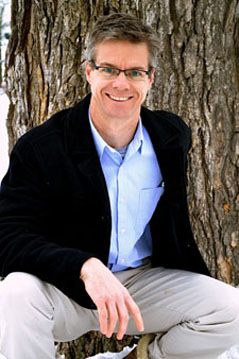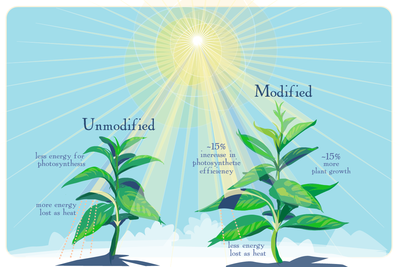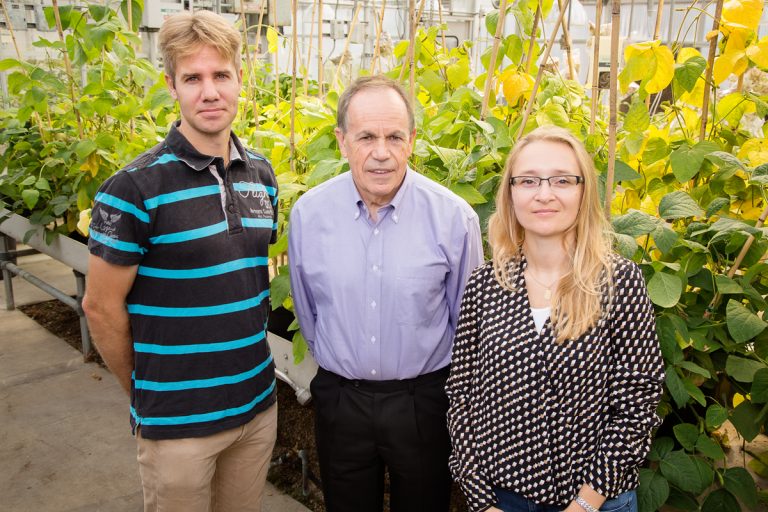Logan Cautiously Welcomes Genetic ‘Breakthrough’
By Tom Porter
Researchers led by agricultural scientists at the University of Illinois recently reported some remarkable results that could one day end up boosting the global food supply.
In a study published in the journal Science, they described how, using tobacco as a test plant (because it’s relatively easy to modify), they performed genetic alterations that effectively boosted the plants’ capacity for photosynthesis—the process by which plants absorb sunlight and use it to grow. The study reports increases in productivity of up to 20 percent.
It’s a development of great interest to Professor of Biology Barry Logan, who teaches courses on plant physiology and ecology, including a course intended for non-science majors on agriculture, and has worked closely with one of the study’s researchers.
What exactly have these scientists achieved?
They’ve genetically manipulated a process found in all green plants that enables them to protect themselves against the harmful aspects of absorbing sunlight. Plants require sunlight to produce the sugars they need to grow via photosynthesis, but like some people, plants can also be sensitive to intense sunlight. Consequently, they have evolved a way to take the light they’ve absorbed and dissipate it to protect themselves against overexposure, like an overflow valve.

This protective process is engaged very quickly as the need arises, but turns off more slowly as light intensity decreases in the afternoon hours, and this is the opportunity that the researchers have tapped into. Through the use of genetic engineering, they have effectively increased the speed at which this process turns off. Scientists already understood the basic biology of the enzymes used to regulate this process, and what these researchers have done is engineer a plant to produce two or three times as much as you would find in a wild plant. This increases the speed at which plants can shut this process off and presents an opportunity for more photosynthesis over the course of a full day, which enables more growth.
Are you excited by the potential of this work?
Firstly, I’m excited on a personal level because this is an area that I have dedicated a lot of energy to understanding. It was the foundation of my PhD thesis and has been a part of the research that I have done with my students. I have also worked closely with Krishna Niyogi, the UC Berkeley professor who collaborated on this study with the scientists from Illinois. He hosted my first sabbatical over twelve years ago, and we worked on some other variants of this pathway back then. I brought some of that work back here and have involved Bowdoin honor students in the research. So as a plant scientist, I’m very happy to see this phenomenon get this level of attention.
As for the implications of tackling world hunger, these are early days and I think it’s premature to speculate on what impact this development might have on crop yields. Although without a doubt, it does open up a new avenue of exploration and way of thinking, so in that way it’s very exciting.
Is this study likely to strengthen the argument in favor of genetic engineering?
Genetic engineering is of course a politically-charged subject, but in my view this study represents an alternative approach which is free of some of the more challenging aspects of genetic engineering. By that, I mean that this is different in that you’re not necessarily talking about the insertion of a foreign gene from one organism into another. You’re tapping into biochemical processes that already exist in plants, and potentially engineering the genes from an organism back into itself.
It is also not an approach to genetic engineering that would lead farmers to use particular herbicides or pesticides. I personally am troubled when some of the outcomes of genetic engineering, viewed as unwelcome by some, are held up as a reason to abandon genetic engineering itself. Genetic engineering is a process, not an outcome, so I favor keeping it on the table as a possible way of tackling food insecurity and the environmental burdens of agriculture. Not to oversimplify too much, but if you compare genetic engineering to a process like blacksmithing, you could say that it might be used to develop weaponry, but also to make ploughs.

In a word, yes. I’m on sabbatical at the moment, but will definitely incorporate this into my teaching when I return. As I said earlier, this is an area I am familiar with through my own research, and in my plant ecophysiology class, we’ve been examining this phenomenon since my first days here. The college has equipped us with the tools and instruments to explore this subject in the lab, greenhouse, and the field, and we’ve also had help through various grants. This latest development will enrich the course and will be the next natural step for us. Last year we experimented with using the Media Commons to do Skype sessions so my classes can hear from additional voices. I haven’t yet invited Krishna Niyogi to do this, but the minute I saw that paper I thought “that seals it, I’m going to ask him to do one of these Skype sessions.” I might have done so anyway, but this is an added incentive. I also hope to get hold of some plant samples from the study that students can examine and explore in their independent projects.



